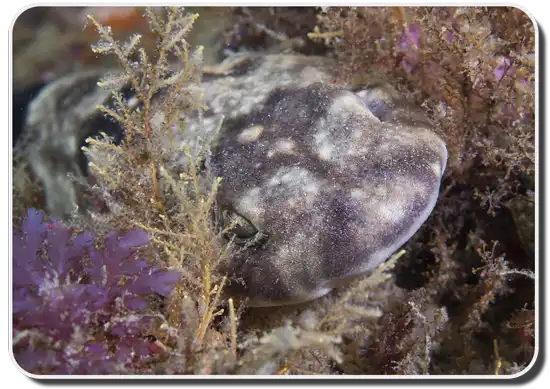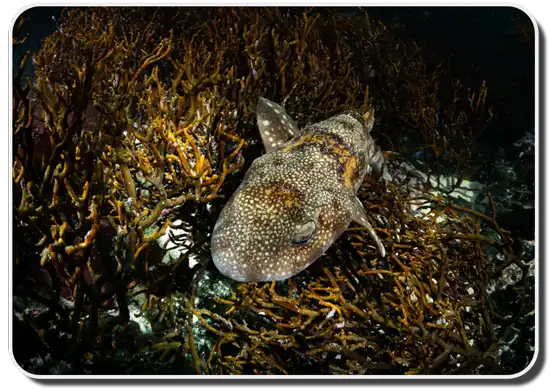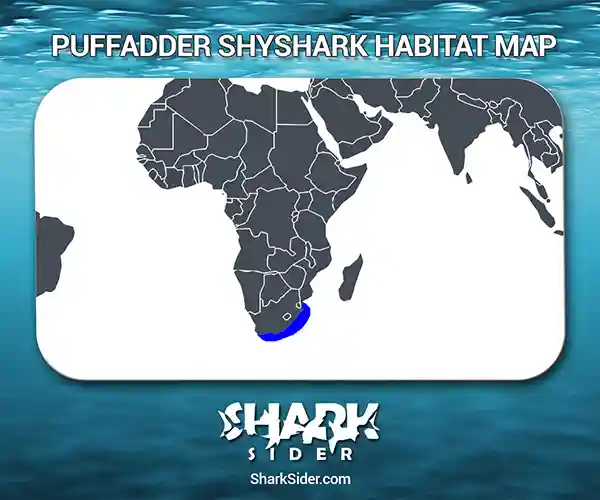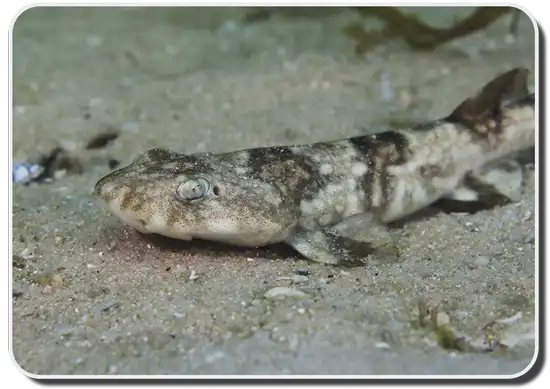Commonly called ‘Happy Eddie,’ the puffadder shyshark is a small species of catshark found in the warm, temperate waters off the coast of South Africa. Belonging to the family Scyliorhinidae, these sharks inhabit depths of 430 ft near rocky or sandy habitats.
George Edwards, an English naturalist, first described the species in his literary works in 1760. He based his findings and research on inspecting three type-specimens caught off the Cape of Good Hope, lost at present. In 1817, Friedrich Siegmund Voigt described this shark as Scyllium D’Edwards based on the account received from Edward’s description.

Initially, the puffadder shark had two recognized forms: the puffer and natal. Both differed from the other in appearance and choice of habitats. However, in 2006, the natal gained the status of a new species named Natal shyshark. In a 2006 analysis, the pufferadder shyshark was its family’s basal member, forming a sister relationship with the brown shyshark and the dark shyshark. However, the Natal shyshark didn’t find a way into the study despite the morphological similarity between the two.
Puffadder Shyshark Scientific Classification |
|
| Kingdom | Animalia |
| Phylum | Chordata |
| Class | Chondrichthyes |
| Order | Carcharhiniformes |
| Family | Scyliorhinidae |
| Genus | Haploblepharus |
| Scientific Name | Haploblepharus edwardsii |
Description
The puffadder shyshark grows to an average length of 19-24 inches. The biggest ever shark caught measured around 27 inches. Compared to the sharks found in the eastern coastal areas, the ones found off the west of Cape Agulhas appear smaller, measuring only 19 inches.
The coloration of the ‘Cape’ form is a sandy brown dorsal side and a white underside. The upper body portion is marked with seven dark reddish-brown saddles with a black edge with small brown and white spots between them. On the other hand, the rare ‘Natal’ form has a cream-colored upper body consisting of darker saddles filled with white spots and a whiter underside.
 They are slender-bodied with a broad and flattened head consisting of a rounded snout, a pair of large, oval-shaped eyes with slit pupils like a cat protected by a simple nictitating membrane. Triangular flaps of fused skins that reach the mouth level cover a pair of large nostrils. They have furrows at the corner of their small mouth, which consists of around 28 tooth rows in their upper jaw and 30 tooth rows in their lower jaw. Males have longer teeth made up of three points, whereas females have shorter teeth consisting of five points on their surface.
They are slender-bodied with a broad and flattened head consisting of a rounded snout, a pair of large, oval-shaped eyes with slit pupils like a cat protected by a simple nictitating membrane. Triangular flaps of fused skins that reach the mouth level cover a pair of large nostrils. They have furrows at the corner of their small mouth, which consists of around 28 tooth rows in their upper jaw and 30 tooth rows in their lower jaw. Males have longer teeth made up of three points, whereas females have shorter teeth consisting of five points on their surface.
The dorsal side of their body has five pairs of gill slits. Similar-sized dorsal, pelvis and anal fins are observed in this shark which is all broad and of moderate size. The first dorsal fin starting behind the originating point of the pelvic fin, whereas the second dorsal fin origins behind the anal fin origin base. The caudal fin of this shark measures approximately 20% of the entire body length and consists of an underdeveloped lower lobe and an upper lobe containing a deep rear notch near the apex.
Leaf-life, thick, and well calcified dermal denticles cover the thick skin of these sharks.
Where do they live
Map Of The Puffadder Shyshark’s Habitat

The Happy Eddie lives in a limited geographical range in South Africa. Their numbers are found in the Atlantic and western Indian Ocean coastal waters of the Langebaan Lagoon (Western Cape Province) to the western shore of Algoa Bay.
There exist two variants of this species, the ‘Cape’ and ‘Natal’ types, which vary in coloration, and habitat based on their geographical locations.They both prefer ocean bottoms, although the ‘Cape’ form inhabit deep, cooler waters up to 49 feet from Cape Town’s surface. In contrast, this shark’s ‘Natal’ type dwells at depths of 130-430 feet off KwaZulu-Natal.
Behavior
Dietary
The puffadder shyshark feeds on a wide variety of prey. Their primary diet consists of crustaceans (shrimp, crabs, crayfishes, mantis, and hermit crabs), annelid worms, and bony fishes (anchovies, jack mackerels, and gobies). They also consume fish offal. While the females prefer crustaceans, the males mostly feed on annelid worms, including polychaetes.
These sharks grasp their food with the help of appropriate dentition. A common octopus was attacked by a puffadder shark, where the shark tore off an arm of the octopus by a sudden-twisting motion.
Reproductory
These sharks are oviparous, where live young pups hatch inside the mother from eggs and develop there until birth. The breeding and reproduction season is not fixed and occurs all year round.
Female sharks lay 1-2 egg capsules at a time, which are brown with unique, transverse, brown bands with a slightly fur-like texture and long, stick tendrils attachéd to the body. These tendrils help the egg cases (1.4–2.0 in. long and 0.6–1.2 in. wide) attach to hard surfaces like sea fans.
Gestation lasts up to three months, after which young individuals measuring 3.5 inches are born. These sharks take around seven years to reach sexual maturity, where the body length for both sexes is around 14-22 inches. They live for 22 years at the most.

Adaptations
There is a presence of special cartilage that connects both halves of their lower jaws. Therefore, their teeth rows are uniformly distributed, contributing towards increase their bite force and strength.
Interactions with humans
Its small size makes this shark so harmless to humans that it is easily approachable and can be caught by hand. Its size also prevents it from being targeted by commercial fisheries such as bottom trawlers and fishing boats. They are often a bycatch of fisheries, where they are disregarded, used as bait for catching lobsters, or killed off as pests.
IUCN has listed the puffadder shyshark as ‘Endangered’ due to its small distribution range and selective habitat. Their habitat lies in an area where heavy fishing takes place, which subsequently causes habitat destruction that can result in wiping off entire populations.
